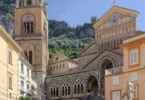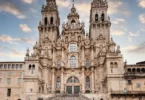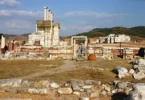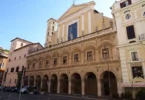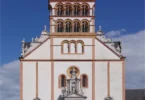
Introduction
The Cathedral Basilica of Our Lady of Coromoto, Guanare (Spanish: Basílica Catedral Nuestra Señora de Coromoto) or more commonly Guanare Cathedral, is an eighteenth century church dedicated to the Virgin of Coromoto and located as its name indicates in Guanare, capital of Portuguesa state in Venezuela.
Cathedral Basilica of Our Lady of Coromoto, Guanare – The first cathedral building of certain importance of Guanare began in 1710 and was completed by Father Francisco Valenzuela in 1742. This church was short-lived as it was damaged by the earthquake of October 15, 1782 and had to be closed. Work on the reconstruction began in 1788 and ended on November 3, 1807. The cathedral was elevated to a Minor Basilica on May 24, 1949, by Pope Pius XII, and declared a historical monument under the Official Gazette No. 36,320 of 2 August 1960.
Notable features of the building include the altarpiece, baroque-colonial Churrigueresque, which was constructed by José Quiñones, as well as stained glass windows produced by X. F. Zettler in Munich.
Our Lady of Coromoto

Cathedral Basilica of Our Lady of Coromoto, Guanare – Our Lady of Coromoto (Spanish: Nuestra Señora de Coromoto), also known as the Virgin of Coromoto (Spanish: Virgen de Coromoto), is a celebrated Catholic image of an alleged apparition of the Virgin Mary. In 1942, she was declared the Patroness of Venezuela.
Our Lady of Coromoto, patroness of Venezuela. She is venerated in the city of Guanare, where she appeared approximately 350 years ago, and throughout the country. When the city of Guanare was founded in 1591, the indigenous people Cathedral Basilica of Our Lady of Coromoto, Guanare who lived there fled into the forest.
First Appearance of the Blessed Virgin to a Coromoto Indian
Cathedral Basilica of Our Lady of Coromoto, Guanare – One day in 1651, the chief of the Coromoto Indian Tribes of Cospes, accompanied by his wife, was going to a part of the mountains where he had farmland. At a creek, a beautiful Lady of incomparable beauty, holding in her arms a radiant and precious child, appeared to the two Indians, walking on the pristine waters of the stream.
They marvelled, staring spellbound at the majestic Lady who smiled lovingly at them and spoke to the chief in his language, telling him ‘Go to where the white men are to receive water on your head so you can go to heaven.’ These words were accompanied by so much unction and persuasiveness that they touched the heart of Cacique and made him willing to meet the wishes of such a lovely Lady.
An honest and good Spanish Christian named Juan Sánchez was travelling to El Tocuyo for an important issue. Somewhere on the mountain the chief of the Coromoto Indians came out to meet him, telling him that a beautiful woman with a child of singular beauty had appeared to him in a creek, giving him the order to go to where the white men lived for them to place water on his head so he may go to heaven. He added that he and all of his tribe were determined to fulfil the desires of such a sublime Lady.
Juan Sánchez, pleasantly surprised by the story of the Indian, said he was going to travel to a town called El Tocuyo and that he would return after 8 days and then would be willing to go with him.
Cathedral Basilica of Our Lady of Coromoto, Guanare – At the given time, all the tribe left with the Spaniard and, as directed by Juan Sánchez, the caravan stopped in the angle formed by the confluence of the rivers Guanaguanare and Tucupido in a place known as Coromoto.
Juan Sánchez immediately went to the Villa of the Holy Spirit of Guanaguanare and told the authorities what had happened. The authorities that governed the Villa arranged for the Indians to remain on Coromoto and placed Juan Sánchez in charge of them (Encomendero), in order to show them the land for them to work and to indoctrinate them in the Christian religion.
Months passed and the work of the construction of the settlement and on the farmlands progressed. The children were in charge of fetching water from the creek for domestic use but often took too long and were punished, until it was discovered that the reason for the delay was that the Beautiful Lady kept appearing, her loving smile and heavenly presence enthralling those who never tired of admiring her, and that is how the time passed.
When adults went to try to see her, they saw nothing, because only the children could see her. Due to the children’s accounts, the appearances of the Beautiful Lady became famous, as well as the waters of the creek. These waters were thought to be miraculous, because several times they were sent to Europe and, after many months, they arrived as fresh as when they were taken from the creek.
The selfless Spaniard did his job with the utmost care, sparing no effort to make their stay in Coromoto comfortable and enjoyable. The aborigines built their village there, received distributed land and happily attended the doctrinal explanation, fruitfully given by the good Encomendero, helped in this arduous task by his wife and two companions. Success crowned this apostolic work as, little by little, the Indians received the baptismal waters and regenerated in this purifying bath.
Second Apparition of the Blessed Virgin in the Coromoto Chief’s Hut

Cathedral Basilica of Our Lady of Coromoto, Guanare – At first, the Chief willingly attended the instruction, then later became angry at his new situation and longed for the solitude of the forests and stayed away from the meetings of Juan Sánchez, not wanting to learn the Christian Doctrine, nor receive the healthy waters of baptism.
On the afternoon of Saturday, 8 September 1652, Juan Sánchez decided to gather together the Indians working in Soropo to meet with his companions and attend the ceremonies that they were to practice in the hut. The Chief flatly refused this invitation and, while his companions honoured the exalted Queen of Heaven and Earth with humble prayers, he, with great indignation and anger, hurried to Coromoto.
The Coromoto chief’s dwelling had only one small doorway. In the evening of Saturday, 8 September 1652, the chief’s wife, her sister Isabel and her son were gathered. The boy was a very graceful twelve-year-old who had come from Soropo that afternoon in order to see his mother. He usually stayed with Juan Sánchez, helping his wife with her multiple daily tasks.
When the Indians least expected it, the chief of the Coromoto arrived, sad and battered: the women attributed the boredom and discontent that they noticed in him to an excess of anger and no one dared say a single word. The Indian was in this state of sadness and melancholy when, by a mystery of affection and love of the Mother of God for a poor son of Adam, she came down to the chief’s hut amid indivisible legions of angels who formed her cortege. Only a few seconds had elapsed since the chief’s arrival when, visibly and bodily, the Blessed Virgin appeared at the threshold of the chief’s hut.
All her being gave off rays of light that bathed the narrow precincts of the hut and were so powerful, as the Indian Isabel declared, they were like the midday sun and yet did not dazzle or tire the vision of those Indians who watched happily in great wonder. Under the influence of these unexpected flashes, which changed the darkness of the night into the light of day, the chief instantly recognized the same beautiful woman who, months before, he had seen over the waters of the placid mountain stream and who he had never been able to erase from his memory.
The emotions of the two Indian women and the child were different from those of the Cacique, brimming with satisfaction and contentment, delighting to see this unparalleled creature, the joy of the angels, the charm of the chosen, all being as a mirror which reflected the infinite perfections of the Divinity. The Cacique probably thought that the great Lady had come to reproach his wrongdoing and prevent his running away. After a few seconds, he broke the silence and, addressing the Lady, said angrily “How long would you pursue me? Well, you can return because I will not do what you tell me to, because of you I left my fields and have come here to work.”
These disrespectful words greatly mortified the Cacique’s woman, who scolded her husband saying “Do not talk like that to the beautiful woman, do not be of such a bad heart.” The Cacique, now consumed with anger and rage, could no longer bear the presence of the Divine Lady, who stood in the doorway giving him such a tender and loving look that was able to melt the most hardened heart.
Desperately he jumped up and took off the wall the bow and a sharp arrow, with the twisted intention of threatening the great Lady and, now crazed, said “You leave me no option but to kill you!” At this very moment the exalted Lady, smiling and serene, entered the hut and approached the Cacique who, in respect of such majesty or because the Virgin was so close that it was not possible to loose the arrow, surrendered his weapons and threw the bow to the ground.
He launched himself on the Sovereign Lady in order to grab her and eject her but, just then, the heavenly vision suddenly disappeared and there followed a gloomy darkness after the bright light that had illuminated the hut, a theatre for such great wonders. Only the dim light of the fire that projected the black silhouette of the Cacique on the wall could be perceived.
Cathedral Basilica of Our Lady of Coromoto, Guanare – The two Indian women and the child felt bitter shame for the bad behaviour of the Cacique and the disappearance of the beautiful woman, reproaching the chief again his clumsy and inconsiderate behaviour towards the sovereign Lady. The Cacique, beside himself and in dumb horror, remained motionless for a long time, with his arms outstretched and intertwined, the same position as they had been when he made the quick grab at the Virgin. He had one hand open and the other closed, as tight as he could, as if something were in it, because he really thought that he had caught hold of the beautiful woman.
Isabel, not understanding what had happened, asked her brother-in-law “Do you know what has happened?” Trembling, the Indian replied, “Here, I have caught her.” The two women, deeply moved and shaken, said, “Show her to us so we may see.” The cacique approached them, opened his outstretched hand and the four indigenous recognized the beautiful woman in the image he held there.
When the Cacique opened his hand, the tiny image shed the same bouncing rays of light that produced a great glow and created the same natural fire that the great Lady had emitted. Cold sweat flowed from the Chief’s body, and with the same anger and rage as before, he wrapped the miraculous image in a sheet and hid it in the straw roof of his house, saying “I have to burn you for you to leave me.”

Juan Sánchez takes over the Holy Relic
Cathedral Basilica of Our Lady of Coromoto, Guanare – The little Indian, who inwardly disapproved of his uncle’s clumsy behaviour, was very sorry about what had happened to the Beautiful Lady. He had seen her, in the creek and in the hut. His Christian heart told him that the treatment the Lady received had not been good, so he carefully arranged the hiding place of the sacred image and decided to tell Juan Sánchez what had happened. The memory of the Blessed Virgin never for a moment left his spirit: what he had seen had made such a deep impression that he was unable to sleep. At about midnight, he slipped out of the hut and hurried to Soropo.
Cathedral Basilica of Our Lady of Coromoto, Guanare – He ran over the plains and through the forests and was not scared of the quiet solitude of the night, nor did he fear the roar of the tiger in the jungle, nor the cries of the beasts in the grasslands. He hurried and soon covered the distance between Coromoto and Soropo. It seems that the Virgin helped him and made the journey lighter. He reached Soropo but everyone was sleeping, so he snuggled up next to the door to wait for dawn.
Juan Sánchez’ wife was surprised when she opened the door of her home in the early hours of Sunday and saw the child there. The little Indian told her, as best as he could, everything he had seen, though with some difficulty because it was not well expressed in his faltered Spanish.
The woman called her husband and said “Juan, yesterday afternoon we gave leave for this child to go to Coromoto to visit his mother, and this morning he is here, saying that last night a very nice woman went to the house and his uncle wanted to shoot her with his bow and arrow, took hold of her and hid her in his house.” Juan smiled and did not believe what the little Indian had said. The child retold the story and, seeing that they still did not believe him, said vehemently “Go to Coromoto now and you will see.”
The little boy insisted they go with him to confirm the truth of the fact. Finally, Juan Sánchez, to dispel all doubts, replied. “Go and get the two mules and I will go with you.” It has to be understood that these two surly mules roamed loose in the savannah and could only be taken with lasso, sometimes taking up to two hours to bring them in. The boy hurried toward the savannah where he found the two mules together and very still, as if they were in a deep sleep. With the greatest of ease he put ropes on them and brought them to the house, without them showing any resistance.
Juan Sánchez, seeing him bringing the two mules in such a short time, was amazed and began to believe what the child had said. Bartolome Sánchez, Juan Sibrián, Juan Sánchez and the Indian boy promptly set off for Coromoto. Arriving near the town, the three Spaniards hid in a ditch three blocks from the house while the boy went into his uncle’s hut in search of the woman he had talked about. Fortunately for the child, the Cacique, his aunt and his mother were together outside on one side of the house.
Unseen by anyone, the child entered the hut. Heart pounding with joy, he took possession of the miraculous image, still in the same place where his uncle had put it, and took it to Juan Sánchez who, upon receiving it from the child’s hands, felt deep emotion as he recognized the effigy of Mary, the august Mother of God, with Jesus in her lap, and respectfully placed it in a silver reliquary that he used to wear around his neck.
Full of admiration and devotion, Juan Sánchez went to the Villa of the Holy Spirit where he told the local priest, the Presbyterian Don Diego Lozano, everything that had happened. As usually happens in these cases, the priest did not believe any of the story, so Juan Sánchez went home and placed the Holy Relic on an altar.

Escape and Death of the Cacique of the Coromotos
Cathedral Basilica of Our Lady of Coromoto, Guanare – Meanwhile, in the afternoon of the same 9 September 1652, the Chief, with all the Indians he had managed to convince, left Coromoto to return to their home forest. The Cacique was in the front of the group. It was evening and the place was very shady because of the profusion of trees. Without realizing it, he stepped on a poisonous snake which, like lightning, sank its teeth into his leg, injecting venom.
There was great consternation in the group because the Indians knew from the colour of the wound and the bite holes that the poison, was deadly. They decided to take to the road with the Chief already dying. Realising death was near, the Cacique probably thought of all the recent developments: the Beautiful Lady, her love and her promise that if he were baptized he would go to heaven.
He began to shout loudly, desperately, asking to be baptised. At that moment, a Creole half-breed from Barinas was passing by and, after asking the Indians the reason for their gathering and talking to the Cacique, fulfilled his wishes and baptized him with a sense of emergency. The Cacique, now calmer, gave his last wishes to his companions, telling them of his repentance and urging them to return where the white men lived, which they did.
In the following months, the fame of the Virgin spread and grew in the people of the region. On the first of February 1654, the Presbyterian Priest Don Diego Lozano, the same who had not believed Juan Sánchez’ story in 1652, appeared and took the image in procession with much devotion and majesty, from Juan Sánchez’ house to the Church in Guanare. The people knew it as the Virgin of Coromoto and many years later she would be chosen as the patron of Venezuela.

Miraculous encounter at the Site of the Last Appearance in 1652
In the late seventeenth century, when the few Spaniards and Creoles who knew the location of the apparitions had died, and the Indians had returned to the mountains, no one in Guanare knew the exact location of where the apparitions had taken place. In 1698 Fray Diego de Olayza, an Augustine monk, came to Guanare from Bogota with an image of Our Lady of Topo, which represented Our Lady at the foot of the Cross. He went around the communities collecting alms accompanied by many people, including Marcos Paredes de San Nicolas.
At the end of the journey, back in Guanare and during the Rosary, everyone saw that the Virgin’s face turned yellow and then resumed its natural colour, but more vivid and beautiful. When the march continued, it was noticed that a shadow covered the face of the image so they stopped for three hours to pray and ask for Divine Mercy, but the shadow remained.
Marcos Paredes, following an inspiration that he had, ordered the raising of a cross on the site and, in doing so, the shadow disappeared. He told the city priest in Guanare everything and asked for permission to erect a small church there. The priest thought that perhaps the Virgin had wanted to mark the place of her appearance and entrusted Mr. Paredes to search for the exact location.
He set out accompanied by Santiago López and Lorenzo Díaz. They toured the area and asked the inhabitants if they knew of the place, but were told that only the Coromoto Indians knew, and it was hard to find them because they lived in the mountain and were rarely seen. Mr. Paredes then decided upon the construction of the chapel in memory of the wonder of the Virgen de Topo. When it started in August 1698, nine Indian riders presented themselves to Santiago Lopez, Simon Sánchez and Pablo Perez (so strange an occurrence that Nicholas Mateos said, I’ve been here 10 years and have never seen one Indian in this place.)
The Cacique Tabares Gaspar said, ‘ have known that a man would come to make a Church for our Lady the Virgin. Tell him if he wants to build it on the site where the Blessed Virgin came down from the sky and my father-in-law took hold of her then we will all come to live here.’ The others added ‘If they build the church where our captain grabbed the Virgin, we will all leave the forest.
Marcos Paredes de San Nicolas said, ‘We want to build the chapel in the same place as the Apparition, but we have been unable to find it.’ Hearing this, Gaspar told another Indian, ‘Go back and call Julian to come with all the families because God has remembered us.’ They dismounted and worshiped an image of the Virgin of Coromoto Paredes had and as they went to find the exact place of the occurrence, Gaspar said, ‘But the site where the Virgin descended from Heaven and my father-in-law took hold of her you have marked with that Cross’.
Everyone recognized that the wonderful incident of the Virgen del Topo and the unexpected departure of Coromoto were caused by Mary so they should honour the memory of her appearance.
Our Lady of Coromoto declared Celestial and Chief Patron of Venezuela
- In 1807, the Presbyterian Jose Vicente Unda completed the construction of the Church of Guanare.
- In 1942, the Venezuelan Bishops decreed and officially proclaimed Our Lady of Coromoto Patroness of Venezuela.
- In 1944, Pius XII himself confirmed, constituted and declared the Virgin of Coromoto Celestial and Chief Patroness of Venezuela.
- On 14 May 1949, the Church of Guanare was elevated to minor basilica by His Holiness Pope Pius XII. The relic left by the Virgin in the Coromoto Indian’s hand is kept there.
- On the 11September 1952, 300 years after her appearance, the sacred image was crowned by Cardinal Manuel Arteaga Betancourt.
- In 1976, under the patronage of the Congregation of the Servants of the Blessed Sacrament, M. Guadalupe, M. Elizabeth, Monsignor Alfonzo Vaz, Monsignor Angel Polacini and other personalities formed the Venezuela Civil Association of the Virgin of Coromoto for the construction of the National Votive Temple of Our Lady on the exact site of the last appearance. The relic of the Virgin was moved there and placed in a special place for veneration by the faithful.
- In January 1996, it was elevated to the status of Sanctuary by His Excellency Monsignor Oriano Quillici, Apostolic Nuncio in Venezuela.
- In February of the same year it was inaugurated by His Holiness John Paul II during his visit to our country. His Holiness Benedict XVI elevated this Sanctuary to Minor Basilica in 2007.
Veneration
The Venezuelan episcopate declared her as Patroness of Venezuela on 1 May 1942, which was ratified by Pope Pius XII on 7 October 1944. The church of Our Lady of Coromoto, in Guanare, was consecrated as National Shrine on 7 January 1996. Pope Benedict XVI elevated the National Shrine of Our Lady of Coromoto to the rank of Minor Basilica. Pope Pius XII crowned her on 11 September 1952. Pope John Paul II reiterated an imposed solemn coronation of Papal decree via Cardinal Agostino Casaroli on 10 February 1985.
Feast Day - 11th September
Annual Feast Day of Our Lady of Coromoto held on 11th September.
Church Visiting Time
- Every Days : 6:30 am to 8:00 am
- Mondays : Closed
Contact Info
26WX+5VF, Guanare 3350,
Portuguesa, Venezuela
Accommodations
How to reach the Cathedral Basilica
Virgin of Coromoto National Airport also known as Guanare Airport is an airport serving Guanare, the capital of the Portuguesa state in Venezuela is the nearby airport to the Cathedral Basilica.


